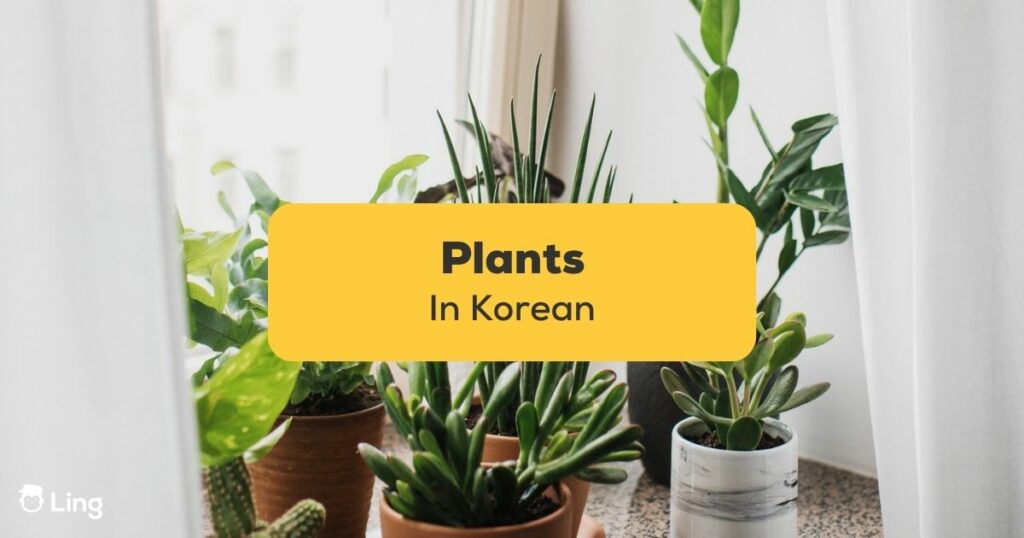Interested in plants 식물 (singmul)? Let’s name some plants in Korean today, like Edelweiss (에델바이스 edelbaiseu) and cactus (선인장 seon-injang)
They say that people who adopt a single plant often find themselves caring for dozens more. The pandemic has truly transformed many people in the world to become plant lovers. Learning about plants is important because, for starters, plants are guaranteed to help protect our environment. Secondly, plants can also be a source of food. That’s why in this blog, we will learn about common plants in Korean.
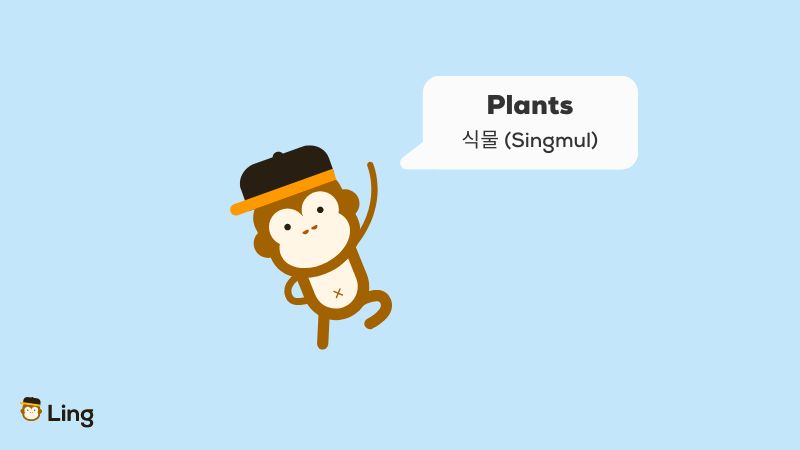
The Korean word for plant is ” 식물 (singmul)”. It is a noun that refers to a living organism that grows in soil, water, or on other plants and frequently has a stem, leaves, roots, and flowers, as well as the ability to produce seeds. The verb “to plant”, however, is translated to as 나무를 심다 (namureul simda).
After learning the words “plant” and “to plant” in Korean, let us now learn the plant’s name in Korean. If you have questions or have something to add, feel free to comment in the comments section.
Famous Plants In K-dramas
Plants matter and these K-dramas can really vouch for that. If you watch K-dramas regularly, you’ll notice that they include plants and flowers most of the time. Before we learn some common plants and their Korean translations, let’s first learn about some unforgettable plants that had exposure in hit K-dramas.
Cherry Tomato Plant (방울토마토 식물 Bangultomato Singmul) – Crash Landing On You
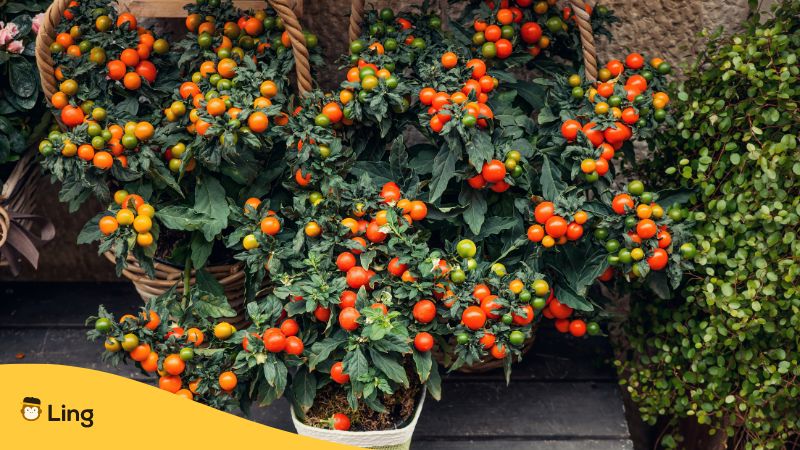
Does the name “Tomato Cultivator” ring a bell? Well, of course, for OG K-drama fans, who could’ve forgotten the tomato plant in the hit K-drama “Crash Landing On You”? Several times, the cherry tomato plant is the centre of attention. It first showed up in Episode 3, when Se-ri gave it to Captain Ri (Hyun Bin) as a gift for him to take with him. At first, he turns down the gift. Se-ri wants him to change his mind, though. “Treat it like a pet and give it love when you water it,” she says. “Water it well and tell it ten nice things every day.”
China Doll Plant (중국 인형 공장 Jungguk Inhyong Gongjang) – Record Of Youth
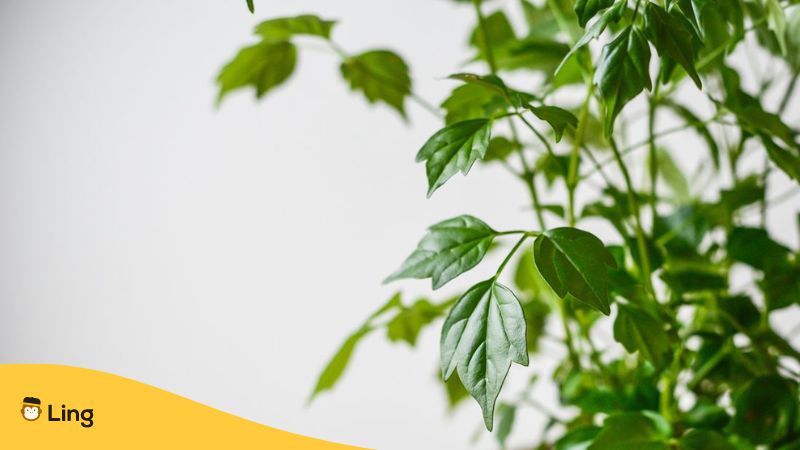
Remember the “Happiness Plant” given by Sa Hye-Jun to An Jeong-Ha for her newly opened studio? That’s a China Doll Plant. He said that it is supposed to make any space happier. Plants do bring happiness. Hye Joon and Jung Ha’s relationship dies out, but Jung Ha still takes care of her plant until the end of the show.
Edelweiss (에델바이스 Edelbaiseu) – Crash Landing On You
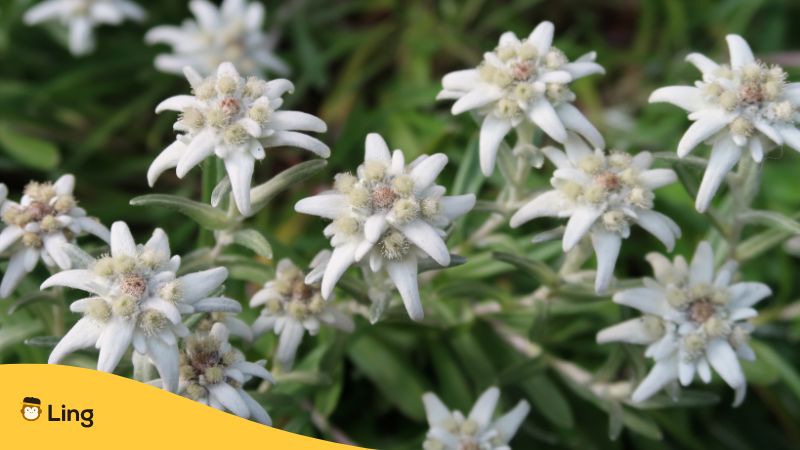
Another famous plant that appeared in K-drama is the Edelweiss. Se-ri and Captain Ri finally meet up in Switzerland, where the edelweiss flower grows. Here is where they make a promise to be together forever. Switzerland is also where they first met. Their love might be forbidden by the law of their country, but a meeting where the Edelweiss blooms is indeed a great plot twist.
Gypsophila (석고자리 Sokkkojari) – It’s Okay Not To Be Okay
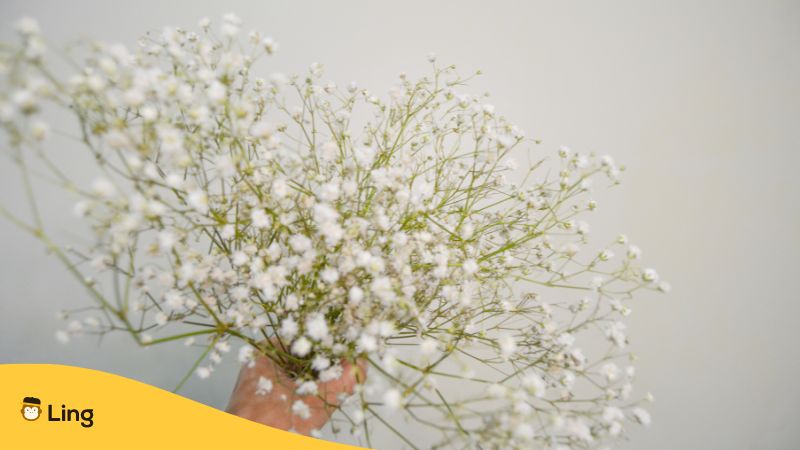
Remember when Moon Gang-tae kissed and gave Ko Moon-young a gypsophila cluster? You swooned, too! Ms. Ko cherishes these dried flowers. Gypsophila symbolizes eternal love. Baby’s Breath flowers are the purest and most innocent. As Gang-tae and Moon-love young’s blooms in It’s Okay Not to Be Okay, we can only agree that this is their flower.
ZZ Plant (Start-Up)
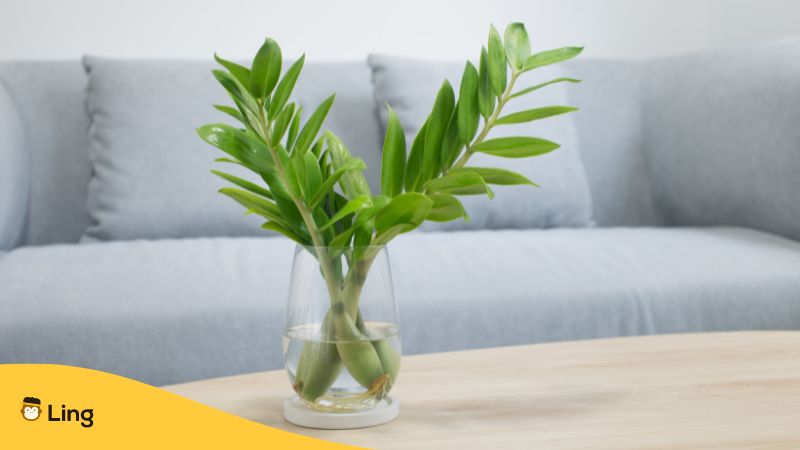
Remember this plant? Well, this is just a plant, but it actually played a big role in this K-drama. Seo Dal-Mi brings a ZZ plant with her when she surprises Nam Do-San at his fake office. She thinks that the plant, which is also called the money tree, will bring luck and success to Do-new San’s business. She doesn’t know that Han Ji-Pyeong really owns the office.
Hanging Plants – 매달린 식물 (Maedalrin Singmul) – Itaewon Class
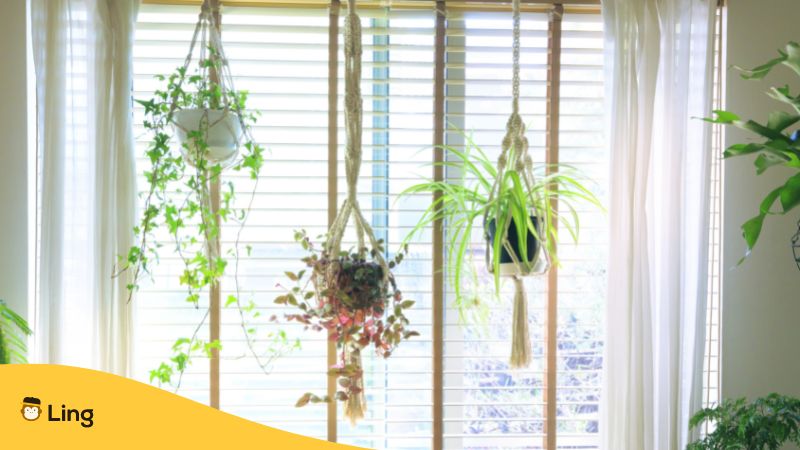
Who didn’t like how DanBam was decorated on the inside? There were lights, pillows, and, most importantly, plants! Yi-seo finds Saeroyi’s hanging plants on the roof early in the morning. Yi-seo, who is always on the cutting edge, even gives advice on how to decorate with hanging plants: “If you hang them in a row, it looks boring. They should be hung at different levels.” Yes, ma’am!
Orchid – 난초 (Nancho)
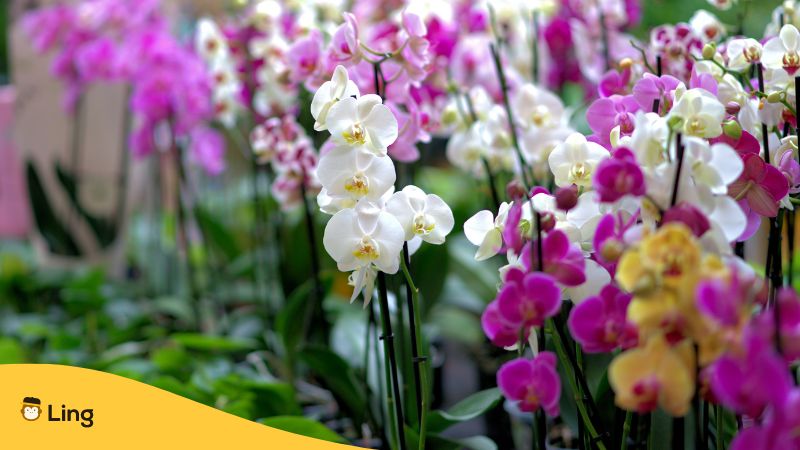
Good thing that Du-shik’s job in the military is to take care of the flowers and trees that were used in special events. Because when Hye-jin’s father kept asking about the orchids, he sent Hye-jin, and when the stepmom makes fun of him for letting his own orchids die, Doo-shik can’t help but figure out what went wrong. Hye-jin’s dad looks at him in a different way and asks about another kind of orchid.
Bamboo – 대나무 (Daenamu)
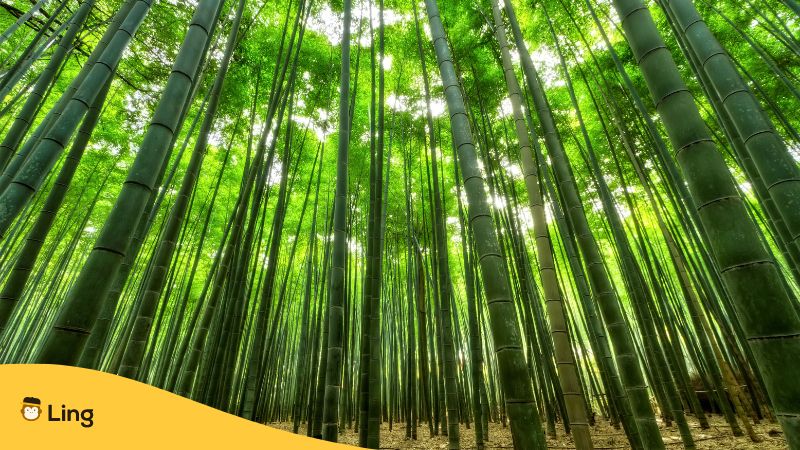
Bamboo is an example of a really common plant that can easily be found anywhere. In Korea, there is a really popular forest that has been a location for K-dramas like “The King: Eternal Monarch”. There are more than a thousand kinds of bamboo plants, and some of them grow to be 50 feet or taller in the wild. But don’t mistake “lucky bamboo” or the popular small houseplant that is often sold with rocks and water as a bamboo plant because it isn’t. Golden bamboo is a real type of bamboo that can grow inside containers.
Common Plants In Korean
Learning about the plants that had K-drama exposures is indeed energizing. Now, let us move on to other common plants in the Korean language.
Rose of Sharon – 무궁화 (Mugunghwa )
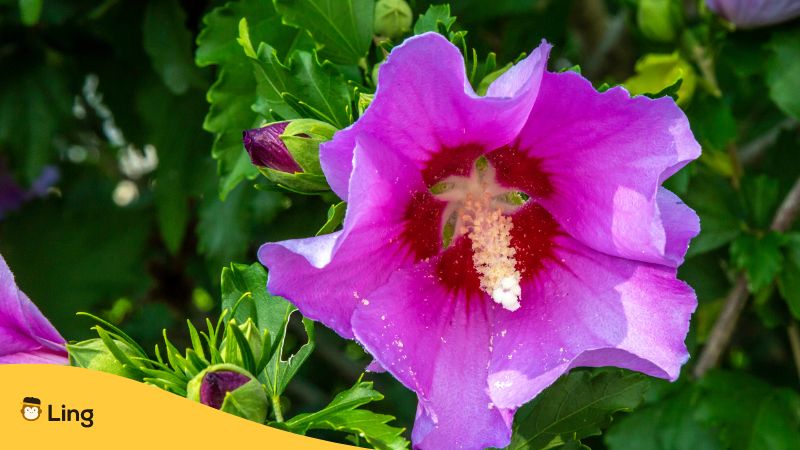
This is Korea’s national flower. It’s a flowering plant with pink, lavender, or white trumpet-shaped blooms. It symbolizes “eternal blossom that never fades”. The Rose of Sharon was revered as a “flower from heaven” even before the Gojoseon era, according to historical documents.
Cactus – 선인장 (Seon-injang)
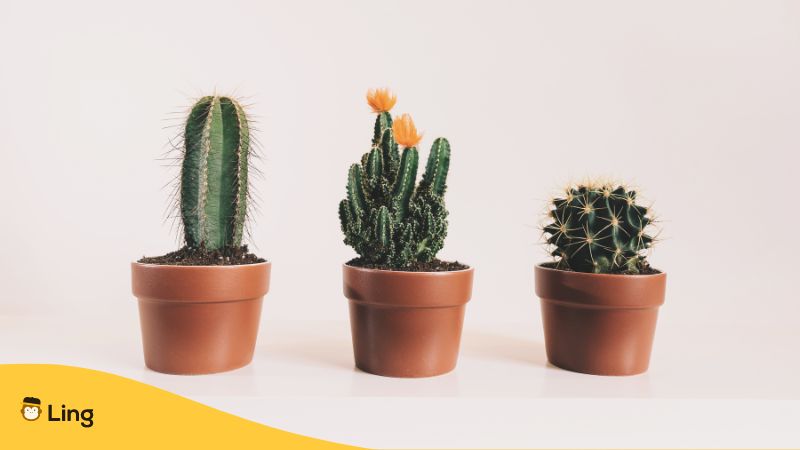
Remember in the K-drama “Start-up” when Do-san gifted a knitted cactus to Dal-mi’s grandmother when they visited the store? Well, that’s just one example of exposure to plants in K-dramas. There are thousands of species of cactus plants in the wild. Desert cacti and forest cacti are two big groups of cacti that are grown as houseplants. Both groups do well indoors with little care and come in many sizes, with the most popular ones being small to medium ones.
Eucalyptus – 유칼리나 (Yukalrina)
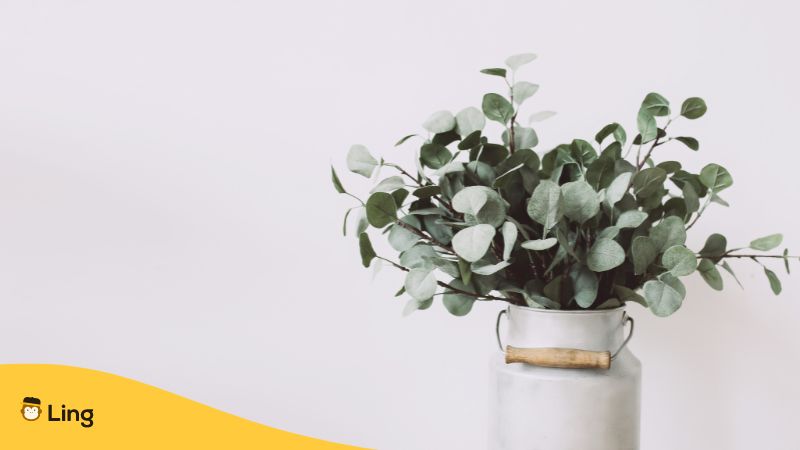
You may know eucalyptus plants best as the koala’s favourite food. In Australia, where it grows naturally, this tree can reach a height of almost 60 feet. But when eucalyptus is grown in a home garden, it usually stays between 6 and 10 feet tall. Fun fact, remember the passionate K-drama with a controversial, original plot and a great cast called “Snowman”? The OST is called “The Eucalyptus Forest”.
Philodendron – 필로덴드론 (Pilrodendeuron)
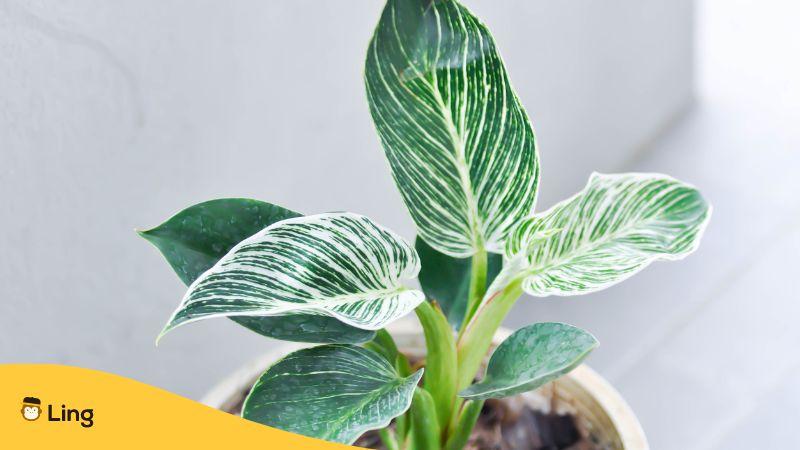
There are a lot of beautiful foliage plants in the Philodendron genus. Philodendrons are great for bringing a bit of their native tropical look into your home. Their leaves are usually big, green, and shiny. These common houseplants are known for how easy they are to grow.
Snake Plant – 뱀식물 (Baemsingmul)
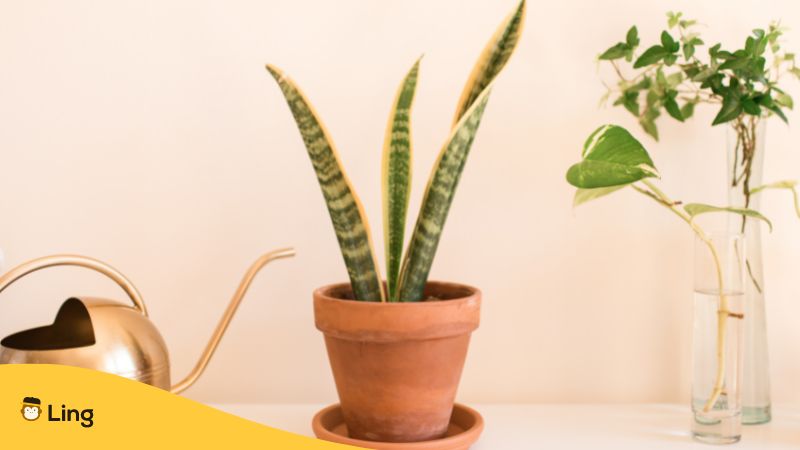
Among the most famous and hardy houseplants is the snake plant. The leaves are stiff and look like swords. The plant can be anywhere from 6 inches to 8 feet tall. Snake plants can be different colours, but most of them have green bands on their leaves and a yellow border. Most of these plants are simple to cultivate and almost impossible to kill.
Other Tree And Plants In Korean
| English | Korean | Romanization |
| Acorn | 도토리 | dotoli |
| Aeonium | aionyum | 아이오늄 |
| African fern | 아프리카 양치류 | apeurika yangchiryu |
| African Milk Tree | 아프리카 우유나무 | apeurika uyunamu |
| Agave | 용설란 | yongsolran |
| Almond Tree | 아몬드 나무 | amondeu namu |
| Alocasia | 알로카시아 | alrokasia |
| Anthurium | 안투리움 | anturium |
| Areca Palm | 아레카 팜 | areka pam |
| Arizona Cypress | 애리조나 사이프러스 | aerijona saipeuroseu |
| Baby Tears | 아기 눈물 식물 | agi nunmul singmul |
| Bonsai | 분재 | bunjae |
| Calathea | 칼라테아 | kalratea |
| Clover | 클로버 | keullobeo |
| Chinese Prickly Ash | 산초 | sancho |
| Fern | 양치류 | yangchilyu |
| Fiddle-Leaf Fig Tree | 피들잎 무화과나무 | pideulrip muhwagwanamu |
| Gasteria | 가스테리아 | kkasseuteria |
| Halcyon Hosta | 할시온 호스타 | halssion hoseuta |
| Herb | 목초 | mogcho |
| Jade Plant | 제이드 플랜트 | jeideu peulraenteu |
| Japanese Chestnut | 밤나무 | Bamnamu |
| Kentia Palm | 켄티아 팜 | kentia pam |
| Lamb’s Ear | 어린 양의 귀 | orin yange gwi |
| Neon Photos | 네온 포토스 | neon potoseu |
| Mad Pupper | 매드 퍼퍼 | maedeu popo |
| Olive tree | 올리브 나무 | ollibeu namu |
| Palm tree | 야자수 | yajasu |
| Peach tree | 복숭아 나무 | bogsung-a namu |
| Pine tree | 소나무 | sonamu |
| Rubber plant | 고무 식물 | gomu singmul |
| Umbrella Plant | 엄브렐라 플랜트 | ombeurelra peulraenteu |
| Zebra Plant | 제브라 식물 | jebeura singmul |
Words Related To Plants In Korean
| English | Korean | Romanization |
| grass | 풀 | pul |
| leaf | 잎 | ip |
| plantation | 농장 | nongjang |
| roots | 뿌리 | ppuri |
| seed/ seeds | 씨 | ssi |
| seedling | 모 | mo |
| sprout | 새싹 | saessag |
| stem | 줄기 | julgi |
| tree/trees | 나무 | namu |
| tree planting movement | 나무 심기 운동 | namu simgi undong |
Plant The Seed Of Your Language Learning Success!

Learning a new language takes patience and determination, just like planting. You’ll start with a small seed and take care of it until it grows into a plant or a tree. Thankfully, Ling app can give you that language-learning journey that will help you learn languages easily and conveniently.
Learning with Ling app is convenient and meaningful. Improve your language skills like speaking, listening, and grammar because you can actually hear the pronunciation of the words with audio recordings from native speakers and learn from the extensive grammar explanations for grammar rules. Sentence examples are also given so that you’ll have an idea of how sentences are formed in the Korean language.
There is actually a lot to discover. All you have to do is create an account using your mobile device or computer. So, download the app and start your free lesson with Ling app now!
